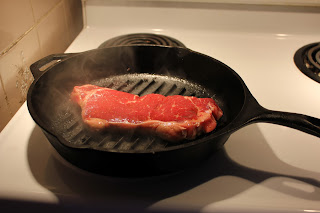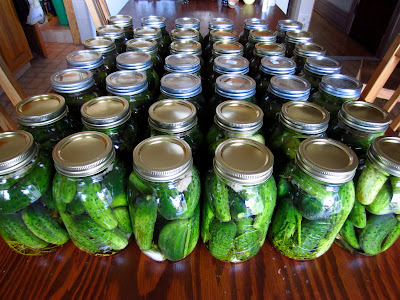In this installment, dear reader, I will show you how to make brine-fermented dill pickles, the superior way to preserve cucumbers. These are also know as "deli-style" or "kosher" dill pickles. They are made without vinegar.
The Science of Dill Pickles
Cucumbers, like other vegetables, can be preserved by immersion in a salty, acidic solution. The combination of salt and acid inhibits the growth of certain bacteria and therefore protects the cucumbers from spoilage and decomposition. Of course, it also considerably alters their texture and taste, usually in a very positive way.
The nature of the acid in which cucumbers are preserved can vary. Like many other vegetables, they can be preserved in vinegar. Any clear or lightly flavoured vinegar, such a cider or white wine vinegar, will do. But they can also be preserved in lactic acid produced through fermentation. This is nothing unusual; there are many other familiar foods, such as sauerkraut, yogurt, and even certain types of sausage, that are created through lactic acid fermentation, which gives them their complex, sour flavour while helping to extend their shelf life. You can easily tell a jar of vinegar pickles and fermented pickles apart; the fluid surrounding the pickles will be clear in former and always cloudy in the latter (fig. 1). Also, in grocery stores, the former will be found on the shelves whereas the latter will often be kept in a refrigerator.

fig. 1
Fermentation, strictly speaking, is any process that consists of bacteria or yeasts (or some combination thereof) consuming sugars and yielding another substance, such as alcohol or lactic acid. For some types of fermentation, a bacterial or yeast culture needs to be added to start the process. This is not the case with cucumbers—the bacteria we seek already naturally occur on their skin.
To get the right kind of fermentation—we are making pickles, not cucumber wine—we need the right kind of bacteria to grow. For this, we need to create the right kind of environment. Very conveniently, it just happens that friendly, lactic acid producing bacteria thrive in salty environments whereas their unfriendly, homicidal cousins don’t. So, to achieve lactic acid fermentation, cucumbers need to be submerged in brine with the right concentration of salt. Too little salt and the unfriendly bacteria may gain a foothold and destroy the cucumbers before they have a chance to sour. (They could also turn into poison.) Too much salt and the pickles may never sour, as even the friendly bacteria’s salt tolerance has its limits.
But why?
Why bother with this bacterial fermentation when you can just dump some vinegar on your cukes? The answer is that fermented pickles, in my not-so-humble opinion, taste better. They are less astringent and have a fuller, more complex, sour flavour. They happen also to be probiotic and are a source of the otherwise tricky to obtain vitamin K. Another advantage is that you can use their brine. In central European folk medicine, pickle (and sauerkraut) brine is thought to be an unparalleled hangover cure. Otherwise, Poles like me add fermented pickle brine to various soups, to a very delicious effect. One such soup is
chłodnik (a.k.a., cold borscht).
Recipe
The key to success for fermented pickles is the relative quantity of cucumbers, water, and salt. If you have more or less cucumber, it is imperative that you adjust the amount of water and salt accordingly to get the right salt concentration in the end. I provide the quantities for 1 kg (2.2 pounds) of cucumbers to allow for easy multiplication. You will probably want to make more than just one kilo, as each kilo will yield about one-and-a-half to two one-litre (one quart) jars of pickles, depending on the size of your cucumbers. The remaining ingredients are flexible. You can change the quantities or omit them altogether (though only a fool would omit dill and garlic). I permit you to flavour your pickles as you like. Please express yourself!
Some people ferment their pickles in a single, large, non-metalic vessel and pack them into sterilized jars later, once they are sufficiently fermented. I prefer packing them into sterilized jars immediately and letting them ferment therein. This method involves less work and allows me to vary the flavourings across jars.
To sterilize, I wash my jars and lids thoroughly (use a dishwasher if you have one) and put them in the oven at 120°C (250°F) for 15 minutes. This is far easier and faster than immersing them one-by-one in boiling water and just as effective.
I add a piece of sourdough bread (whole wheat or rye) to each jar. Sourdough breads contain friendly bacteria and naturally occurring yeasts that will complement the bacteria that dwell on the cucumbers’ skin and help kick start the fermentation process. The greater diversity of bacteria will also impart the pickles with a fuller, funkier bouquet. This is a matter of preference—I permit you to leave the bread out.
Ingredients
To be multiplied to match the quantity of cucumbers:
- 1 kg Kirby or other pickling cucumbers*
- 34 g salt (iodine-free)
- 700 mL water
- 3-4 cloves of garlic
Per 1 litre (1 quart) jar:
- 1 branch of dill flowers (fig. 2) or 1 tsp dill seeds
- ½ tsp mustard seeds
- ½ tsp black peppercorns
- ½ tsp coriander seeds
- ¼ tsp chili flakes
- 1 bay leaf
- 1 small square of sourdough whole wheat or rye bread (about 2 cm x 2 cm or 1” x 1”)
*The smaller the cucumbers, the better. They will have a thinner skin, be more crunchy, and be easier to pack into the jars.

fig. 2
Procedure
- You will mix the water and salt and bring to a boil in pot. You will allow the brine to cool to room temperature before using.
- You will thoroughly wash the cucumbers. You must remove any stems that remain attached to them. Discard any cucumbers that are excessively wilted, rotting, or moldy.
- You will fill the sterilized jars with the flavourings.
- You will insert the cucumbers into the jars. Pack as many as you can in up to 3-4 cm (1-1.5”) from the top of the jar to leave room for the bread and to ensure complete immersion in brine. Pretend you are doing a puzzle (fig. 3).
- You will put a square of bread in each jar, if using.
- You will fill the remaining space in each jar with the cooled brine. Make sure the cucumbers are completely immersed but leave a bit of headspace between the surface of the brine and the lip of the jar. If the fluid touches the lid, it may cause it to corrode.
- You will put the lids on the jars but you will not seal them tightly. Gases that form while the pickles ferment must be allowed to escape or the jars will pressurize.
- You must now store the jars somewhere away from sunlight, where they will be at room temperature.

fig. 3
After three or four days, you will have what are known as half-sour pickles. You may eat them at this point—they will be slightly sour but will still retain some of the natural freshness of a cucumber. If you want to keep some of your pickles in this half-sour state, you must transfer them to the refrigerator, which will effectively stop the fermentation process.
Those that remain at room temperature will become full-sour pickles after approximately two weeks. The cucumbers will have taken on the characteristic, dull yellow-green colour and the brine will have become cloudy (fig. 4). After this point, the environment in the jars will become so acidic that even the friendly lactic acid producing bacteria will stop functioning—they will have in effect pickled themselves to death. The fermentation process will therefore grind to a halt and the flavour of the pickles will stop evolving. You must now tighten the lids on the jars to prepare your pickles for long-term storage. They store perfectly well at room temperature for up to a year. However, after opening a jar, you should store it in the fridge and eat the contents within a month.

fig. 4
Good appetite.































